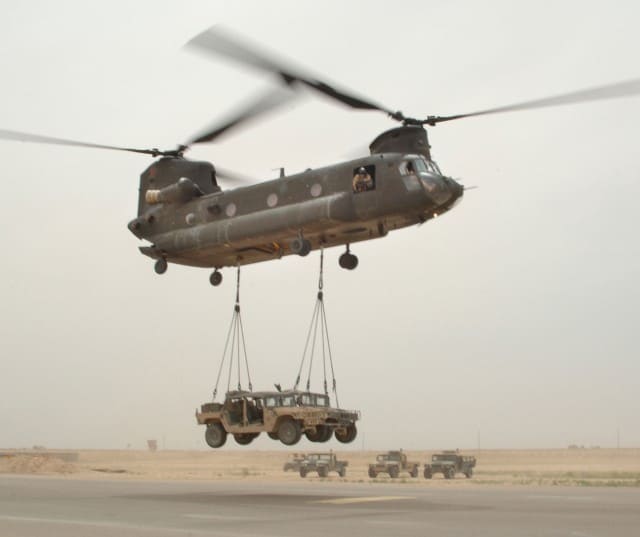An Underslung Load, or sometimes called external lift, is a method for airlifting over sized cargo by carrying it beneath a helicopter. It is used to transport everything from vehicles, weapons, containers, food and general equipment. This method requires special equipment like strops/pendants, slings or cargo nets. This underslung equipment allows for easier pick-up and delivery of items, while reducing the risk of ground crew danger.

(U.S. Army photo by Specialist Teddy Wade) (Released)
It is essential to have well-trained soldiers in order to conduct successful sling load operations. There is a focus on certification, training and equipment.
Proper rigging and inspections of loads are absolutely crucial to the success of all sling load missions. Sling load operations are conducted under the Quartermaster General. According to Army.Mil, The Sling Load office “also provides technical assistance to all active and reserve component military units, monitors sling load training for all branches of service (Army, Navy, Air Force, and Marines) and the U.S. Coast Guard, and operates the Sling Load Inspector Certification Course.”
The Sling Load Inspector Certification Course teaches military members how to properly inspect and prepare the cargo loads for helicopter transport. This five-day course conducted by the Sling Load Office trains E-4s and above in sling load operations.
Sling Load course information:
Students are trained in the following areas: types of helicopters and limitations, cargo hook reach pendants, 10K and 25K sling sets, basic hardware and expendables, cargo carrying devices, preparation and set up of a PZ/LZ, safety equipment, hook-up team and signalman duties & responsibilities, and the proper rigging and inspection of loads. All training is conducted in accordance with FM 4-20.197, Multi-service Helicopter Sling Load: Basic Operations and Equipment. The course is conducted as a resident course at Fort Lee, and as a mobile training course at various host installations. -Army.Mil
As always, in order to conduct a sling load successful mission, there must be excellent communication between those in the air and on the ground. Sling load students must face winds, propellers and heavy dangerous machinery while practicing sling load operations. The helicopter pilot must hover the aircraft while allowing for the others soldiers to conduct a successful hookup. Soldiers brave extreme conditions in order to operate sling load missions successfully, especially in areas where terrain is rugged and poor roads make transport even more difficult.

